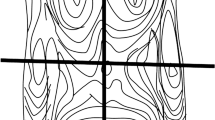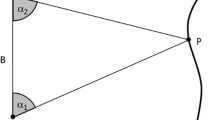Abstract
New noninvasive techniques, amongst them structured light methods, have been applied to study rachis deformities, providing a way to evaluate external back deformities in the three planes of space. These methods are aimed at reducing the number of radiographic examinations necessary to diagnose and follow-up patients with scoliosis. By projecting a grid over the patient’s back, the corresponding software for image treatment provides a topography of the back in a color or gray scale. Visual inspection of back topographic images using this method immediately provides information about back deformity, but it is important to determine quantifier variables of the deformity to establish diagnostic criteria. In this paper, two topographic variables [deformity in the axial plane index (DAPI) and posterior trunk symmetry index (POTSI)] that quantify deformity in two different planes are analyzed. Although other authors have reported the POTSI variable, the DAPI variable proposed in this paper is innovative. The upper normality limit of these variables in a nonpathological group was determined. These two variables have different and complementary diagnostic characteristics, therefore we devised a combined diagnostic criterion: cases with normal DAPI and POTSI (DAPI ≤ 3.9% and POTSI ≤ 27.5%) were diagnosed as nonpathologic, but cases with high DAPI or POTSI were diagnosed as pathologic. When we used this criterion to analyze all the cases in the sample (56 nonpathologic and 30 with idiopathic scoliosis), we obtained 76.6% sensitivity, 91% specificity, and a positive predictive value of 82%. The interobserver, intraobserver, and interassay variability were studied by determining the variation coefficient. There was good correlation between topographic variables (DAPI and POTSI) and clinical variables (Cobb’s angle and vertebral rotation angle).








Similar content being viewed by others
References
Agin G, Binford T (1973) Computer description of curved objects. In: Proceedings of the third International Joint Conference on Artificial Intelligence, pp 629–640
Armstrong GWD, Livermore NB, Suzuki N, Armstrong JG (1892) Non-standard vertebral rotation in scoliosis screening patients. Spine 7:50–54
Buendía M, Salvador R, Cibrián R, Laguía M, Sotoca JM (1999) Determination of the object surface function by structured light: application to the study of spinal deformities. Med Phys Biol 44:75–86
Cote P, Kreitz BG, Cassidy JD, Dzus AK, Martel J (1998) A study of the diagnostic accuracy and reliability of the scoliometer and Adam’s forward bend test. Spine 23:796–803
Golberg CJ, Kaliszer M, Moore DP, Fogarty EE, Dowling FE (2001) Surface topography, Cobb angles and cosmetic change in scoliosis. Spine 26:E55–E63
Inami K, Suzuki N, Ono T, Yamashita Y, Kohno K, Morisue H (1999) Analysis of posterior trunk symmetry index (POTSI) in scoliosis. Res Spinal Deform 2 59:85–88
Iwahara T, Imai M, Atsuta Y (1998) Quantification of cosmesis for patients affected by adolescent idiopathic scoliosis. Eur Spine J 7:12–15
Kojima T, Kurokawa T (1992) Quantification of three-dimensional deformity of idiopathic scoliosis. Spine 17(Suppl):22–29
Liu XC, Thometz JG, Lyon RM, McGrady L (2002) Effects of trunk position on back surface-contour measured by raster stereophotography. Am J Orthop 31:402–406
Mínguez MF (2002) Valoración de técnicas de luz estructurada en la determinación de deformidades del raquis. Doctoral Thesis. Valencia University
Morrissy R (1999) School screening for scoliosis. Spine 24:2584–2591
Oxborrow NJ (2000) Assessing the child with scoliosis: the role of surface topography. Arch Dis Child 83:453–435
Suzuki N, Ono T, Tezuka M, Kamiishi S (1992) Moiré topography and back shape analysis—clinical application. In: J Dansereau (ed) International symposium on three dimensional scoliotic deformities. Gustav Fisher Verla, Stuttgart, pp 124–128
Takasaki H (1973) Moiré topography. Appl Optics 12:845–850
Theologis TN, Jefferson RJ, Simpson AHRW, Turner-Smith AR, Fairbank JCT (1993) Quantifying the cosmetic defect of adolescent idiopathic scoliosis. Spine 18:909–912
Theologis TN, Fairbank JC, Turner-Smith AR, Pantazolupoulos T (1997) Early detection of progression in adolescent idiopathic scoliosis by measurement of changes in back with the integrates shape imaging system. Spine 22:1223–1227
Turner-Smith AR (1988) A television computer-D surface shape measurement system. J Biomech 21:515–529
Viviani GR, Budgell L, Dok C et al (1984) Assessment of accuracy of the scoliosis school screening examination. Am J Public Health 74:497–498
Acknowledgments
This research was supported by grant PI 030735 from the Ministerio de Sanidad y Consumo. This study complies with the current laws of Spain and has been approved by the Ethics Committee of the Clinic University Hospital of Valencia.
Author information
Authors and Affiliations
Corresponding author
Rights and permissions
About this article
Cite this article
Mínguez, M.F., Buendía, M., Cibrián, R.M. et al. Quantifier variables of the back surface deformity obtained with a noninvasive structured light method: evaluation of their usefulness in idiopathic scoliosis diagnosis. Eur Spine J 16, 73–82 (2007). https://doi.org/10.1007/s00586-006-0079-y
Received:
Accepted:
Published:
Issue Date:
DOI: https://doi.org/10.1007/s00586-006-0079-y




